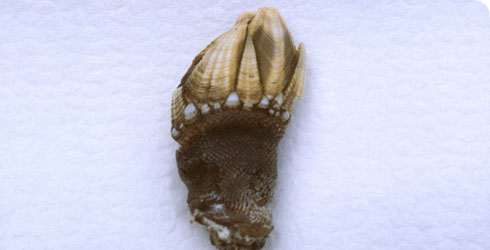Reproduction and life history
Capitulum mitella is hermaphrodite and when acting as a male, it is able to fertilise the eggs of a neighbour acting as a female as these are laid into the 'female's' mantle cavity.
As is typical for thoracican barnacles, C. mitella holds the fertilised egg masses in the mantle cavity until the eggs hatch. The first stage barnacle nauplius larva is then released into the surrounding water.
First stage barnacle nauplii do not feed, but survive on the remnants of egg yolk in the anterior midgut (lecithotrophic)
Within a few hours they moult to second stage nauplii.
The second to sixth stage nauplii filter-feed on phytoplankton over several days (planktotrophy), increasing in size at each moult, until a final moult to the cypris stage.
The cypris larva is non-feeding, surviving on the lipid reserves built up by the planktotrophic nauplii, and selects the settlement site for final fixation.
Metamorphosis to the juvenile barnacle follows and the barnacle takes up the adult mode of life.
Toolbox
Glossary
Hermaphrodite
An animal that has reproductive organs of both males and females of the species, and can act as ‘male’ or ‘female’ in the reproductive process.
Nauplius
First stage larvae of crustaceans.
Phytoplankton
Tiny water dwelling plants.
Lower eulittoral zone
An area of shoreline that ranges from the high water mark to areas that are permanently submerged.
Sessile
Permanently attached and not free to move.
